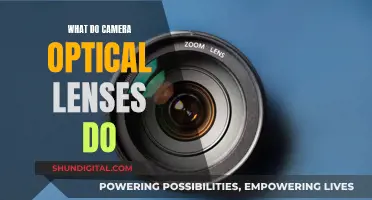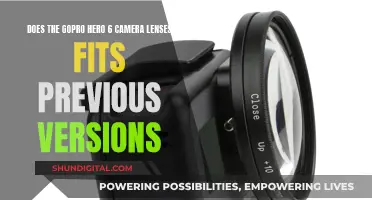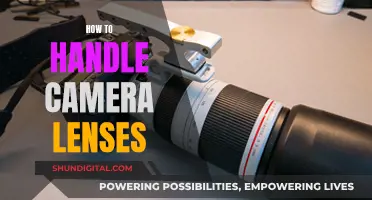
Camera lenses are not completely interchangeable between brands. While a camera can use different kinds of lenses, such as standard, wide-angle, or macro, a Canon lens won't fit a Nikon camera, for example. Some independent brands do make lenses that fit most common camera brands, but they may not offer the same quality as the original manufacturer.
Camera lenses are designed for particular purposes, camera types, and models. For instance, a full-frame camera requires a full-frame lens, and macro photography demands a dedicated macro lens.
| Characteristics | Values |
|---|---|
| Camera lenses are interchangeable | Yes, but not across all brands and types of cameras. |
| Camera lenses are universal | No. |
| Camera lenses are brand-specific | Yes. For example, a Canon lens won't fit a Nikon camera. |
| Camera lenses are model-specific | Yes. Even lenses made by a camera manufacturer such as Nikon don't fit all Nikon camera models. |
| Camera lenses are mount-specific | Yes. Different cameras within a brand can have different mounts. |
| Camera lenses are type-specific | Yes. Lenses are designed for specific camera types, including full-frame, macro, and mirrorless cameras. |
What You'll Learn

Camera lenses are not universal
Camera lenses are designed for particular purposes, camera types, and camera models. For example, a full-frame lens is needed for a full-frame camera, and a dedicated macro lens is needed for macro photography. A Nikon camera, for instance, requires either a Nikon-produced lens or a third-party lens fabricated specifically for Nikon cameras. However, even lenses made by a camera manufacturer such as Nikon don't fit all Nikon camera models.
The reason that lenses aren't interchangeable across brands and camera types is mainly attributed to the mounts. While many third-party lenses clearly advertise which brand the lens is made for, knowing the brand isn't always enough. Different cameras within a brand can have different mounts. For example, Canon has the EF-lens mount and the newer EF-S-mount; Nikon has the F-mount and the 1-mount.
Another factor that affects the interchangeability of lenses is the registration distance (or flange focal distance), which is the distance the lens needs to be held away from the image plane. Each mount system is designed with a specific distance, and if the lens is held closer or farther away, its focusing capabilities will be compromised.
In addition, adapting a lens from one brand to another may result in a loss of functionality. For example, you may lose autofocus, aperture control, and metering when using an adapter to connect two different brands of lenses and cameras.
While it is possible to find adapters that allow users to mount DSLR or rangefinder lenses on mirrorless bodies, these adapters may not always be worth it in the long run, as the camera won't be able to use all the features of a different brand of the lens.
Lens Thread Compatibility: A Universal Camera Feature?
You may want to see also

Lenses are often brand-specific
Each DSLR brand has its own mount. Canon, for example, has four mount types, and its lenses are designed to work with its cameras, not those of its competitors. Nikon, meanwhile, uses the F-mount, one of the oldest mounts still in use.
The reason lenses aren't interchangeable across brands is mainly to do with the mounts. While many third-party lenses clearly state which brand they are made for, knowing the brand isn't always enough. Different cameras within a brand can have different mounts.
Camera manufacturers often have a range of lenses designed specifically for their cameras. While independent brands may produce lenses that fit most common camera brands, they are often not as good as those made by the original manufacturer.
Lens Compatibility: Understanding Camera Lens Interchangeability
You may want to see also

Mounts differ between camera types
The mounts on your camera and lens must match for them to be compatible. Different camera brands use different mounts, and even within brands, different camera models can have different mounts. Therefore, it is important to check the mount type of your camera before purchasing a lens.
Canon cameras, for example, have four types of mounts: the EOS APS-C R System or EOS Full-frame R System mirrorless, the EOS APS-C DSLR, the EOS full-frame DSLR, and the EOS M series APS-C mirrorless. Nikon cameras, on the other hand, use the F-mount, one of the oldest mounts still in use, as well as the Nikon 1-mount for their compact system cameras.
Third-party lens manufacturers like Sigma, Tamron, and Tokina produce lenses that are compatible with multiple camera mounts. For instance, Sigma uses the EF and EF-S mounts for Canon cameras, while also manufacturing lenses for the Nikon F-mount.
While it is possible to use adapters to attach lenses from other brands, this may not be ideal as the camera may not be able to utilise all the features of the lens. Additionally, some adapters may only provide a physical connection without enabling electronic communication between the lens and camera.
What Shape Makes Camera Lenses Work?
You may want to see also

Adapters can be used to attach lenses
Firstly, it is important to understand that different camera brands use different lens mount systems. The mount system specifies how the lens and camera body physically connect, and may also include electronic communication between the lens and camera. If the lens and camera are not in the same mount system, an adapter will be needed to physically attach the lens to the camera body. However, even with an adapter, the electronic communication between the lens and camera may not be supported, leading to a loss of functionality.
For example, a Canon lens will not fit a Nikon camera without an adapter. While third-party adapters are available, they may not enable all the features of the Canon lens to work with the Nikon camera. This is because camera manufacturers design their lenses and camera bodies to work together, and they often use proprietary mount systems that are not compatible with other brands.
In some cases, it may be possible to adapt lenses from one brand to another using an adapter that only addresses the physical connection between the lens and camera body. However, this may result in a loss of autofocus, aperture control, metering, and other electronic functions. Additionally, the image quality may be compromised due to differences in registration distance (the distance between the lens and the image plane) and sensor stack thickness.
Another challenge when adapting lenses from one brand to another is that the lens mount alone does not always provide enough information to determine compatibility. Different camera models from the same brand may use different mounts, so it is important to identify the specific mount for both the lens and the camera body.
Furthermore, adapting lenses between different sensor sizes (e.g. full-frame to crop sensor) can also present challenges. Adapting a lens designed for a larger sensor to a camera with a smaller sensor may result in severe vignetting, while adapting a lens designed for a smaller sensor to a camera with a larger sensor may require an adapter with optical elements, which can be expensive and degrade image quality.
Despite these challenges, it is possible to adapt lenses between some brands with varying levels of success. For example, Olympus and Panasonic use the same Micro Four Thirds mount, and Sony's A-mount is the same as Minolta's AF mount. Additionally, third-party lens manufacturers like Sigma, Tamron, and Tokina produce lenses for multiple camera mounts.
When considering adapting lenses between different brands, it is important to research the specific lens and camera body combinations to understand the limitations and potential loss of functionality. While it may be possible to physically attach the lens to the camera body with an adapter, the electronic communication and image quality may be compromised. In some cases, it may be more cost-effective and provide better results to invest in lenses designed specifically for the camera body.
Thailand Camera Gear: Are Lenses a Bargain?
You may want to see also

Lens mounts vary by brand
Canon cameras have four mount types:
- EOS APS-C R System or EOS Full-frame R System mirrorless (indicated by a red line on the lens mount)
- EOS APS-C DSLR (red circle and white square on the lens mount)
- EOS full-frame DSLR (red circle on the lens mount)
- EOS M series APS-C mirrorless (white circle on the lens mount)
Nikon uses the F-mount, which is one of the oldest mounts still in use, having been introduced in 1959. They also have the 1-mount for their compact system cameras.
Other lens mounts include:
- Micro Four Thirds mount (used by Olympus, Kodak, and Panasonic)
- EF and EF-S mounts (used by Sigma, Tamron, and Tokina)
- SL mount (used by Leica for full-frame DSLR cameras)
- K mount (used by Pentax for full-frame DSLR cameras)
- M mount (used by Canon for mirrorless cameras)
- E mount (used by Sony for mirrorless cameras)
- X mount (used by Fujifilm for mirrorless cameras)
- L mount (used by Panasonic for mirrorless cameras)
Camera Lenses in China: Cheaper or Expensive?
You may want to see also
Frequently asked questions
No, camera lenses are not interchangeable between brands. A Canon lens won't fit a Nikon camera, for example. However, there are third-party mounting adapters available.
Interchangeable lenses provide the user with a wider choice of image-capture capabilities. While there are general-purpose lenses, the true power of interchangeable lenses is in the specialised lenses that are available.
Camera brands use a range of lens mounts, so check the characteristics of your camera before buying lenses. Here are some of the most popular lens mounts:
- Full-frame DSLR cameras: EF and RF mounts for Canon, F mount for Nikon, SL for Leica, K mount for Pentax
- Cropped-sensor DSLR cameras: EF-S mount for Canon, F mount for Nikon, TL for Leica, K mount for Pentax
- Mirrorless cameras: M mount for Canon, 1 and Z mounts for Nikon, E mount for Sony, X mount for Fujifilm, L mount for Panasonic







